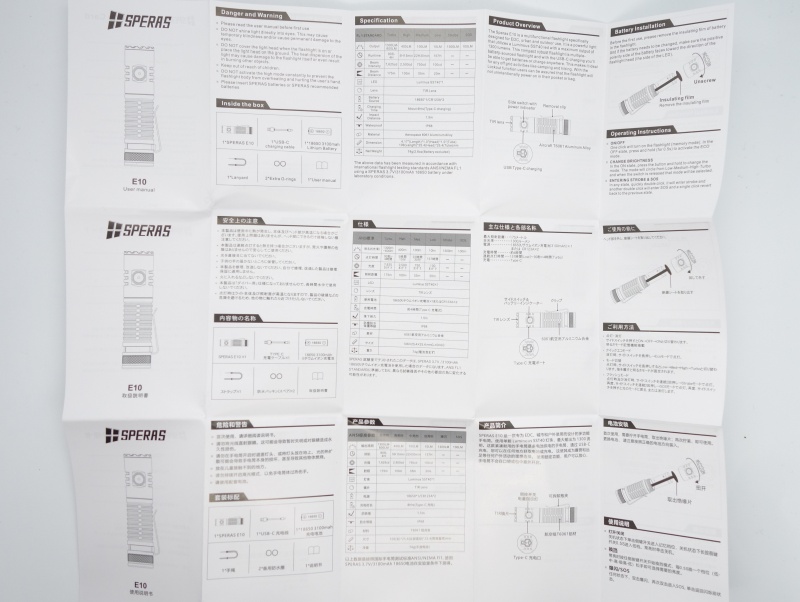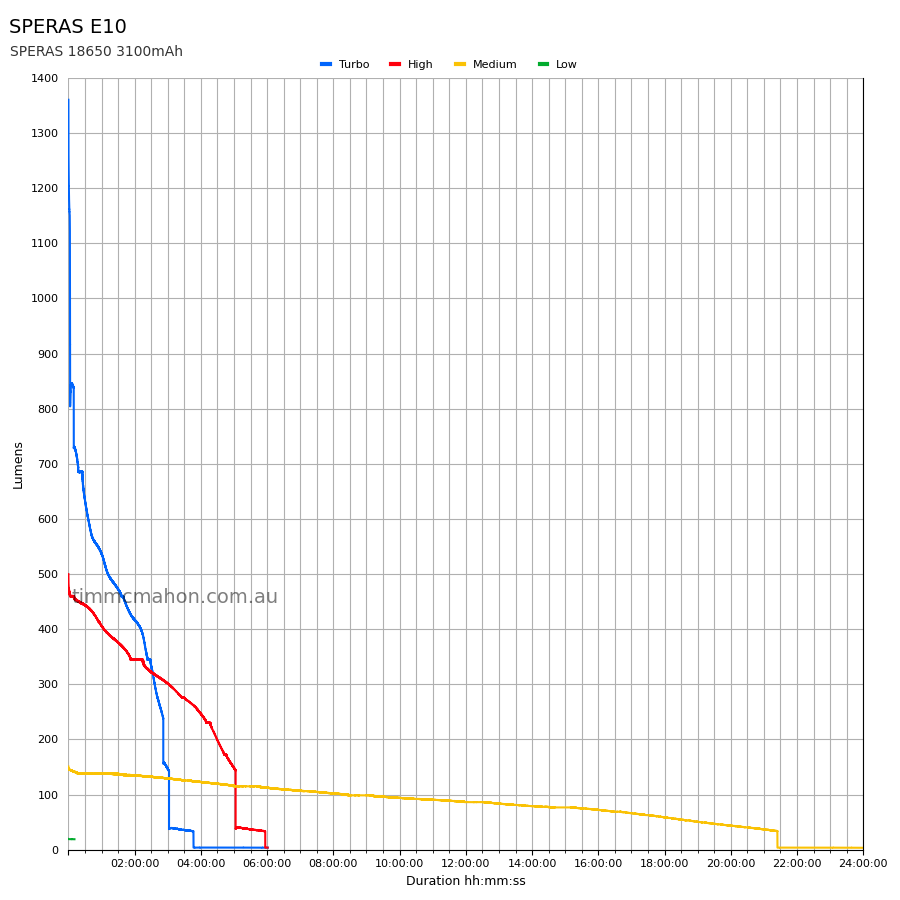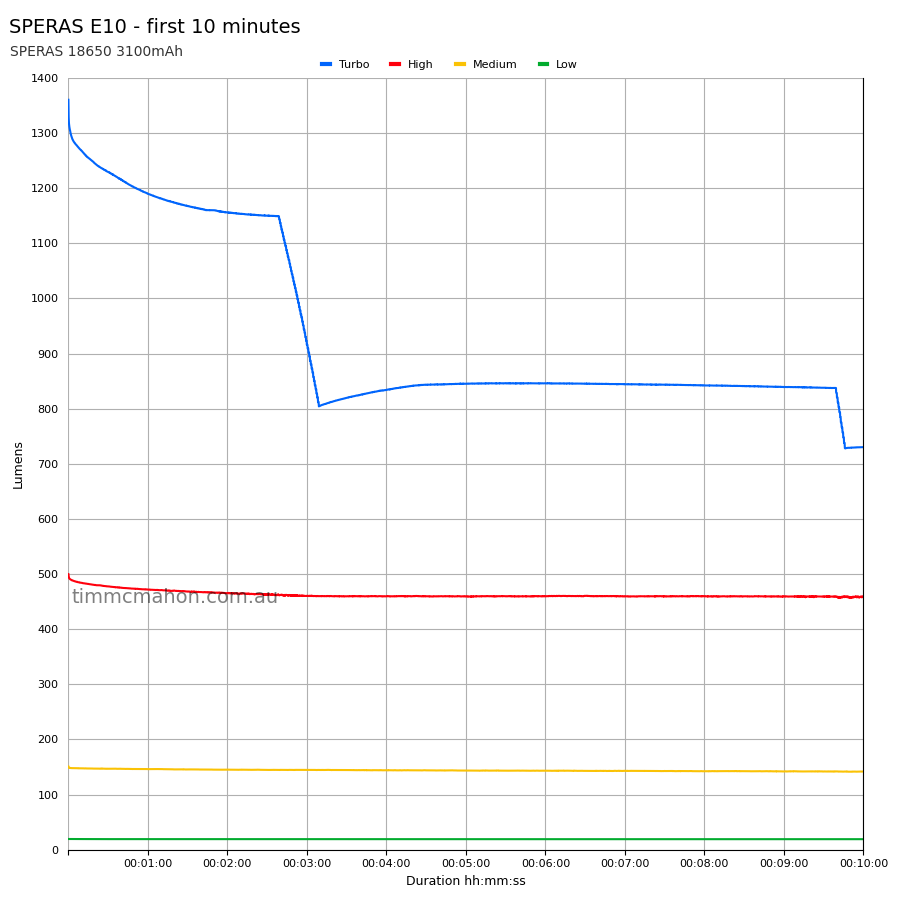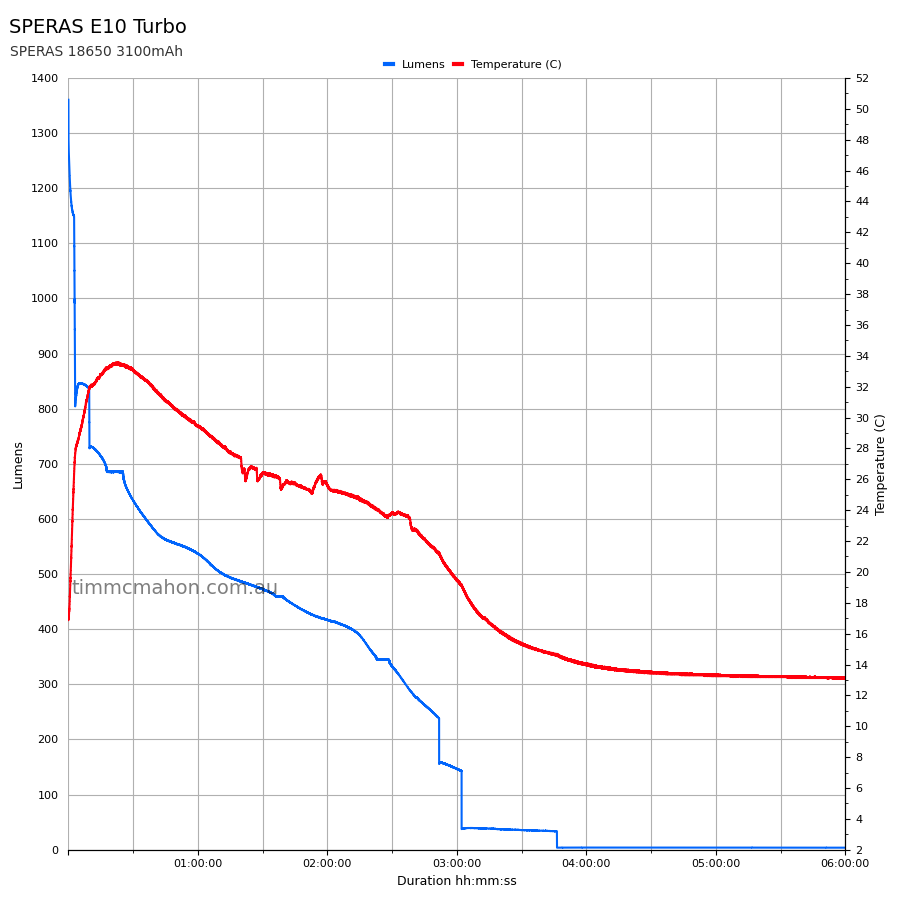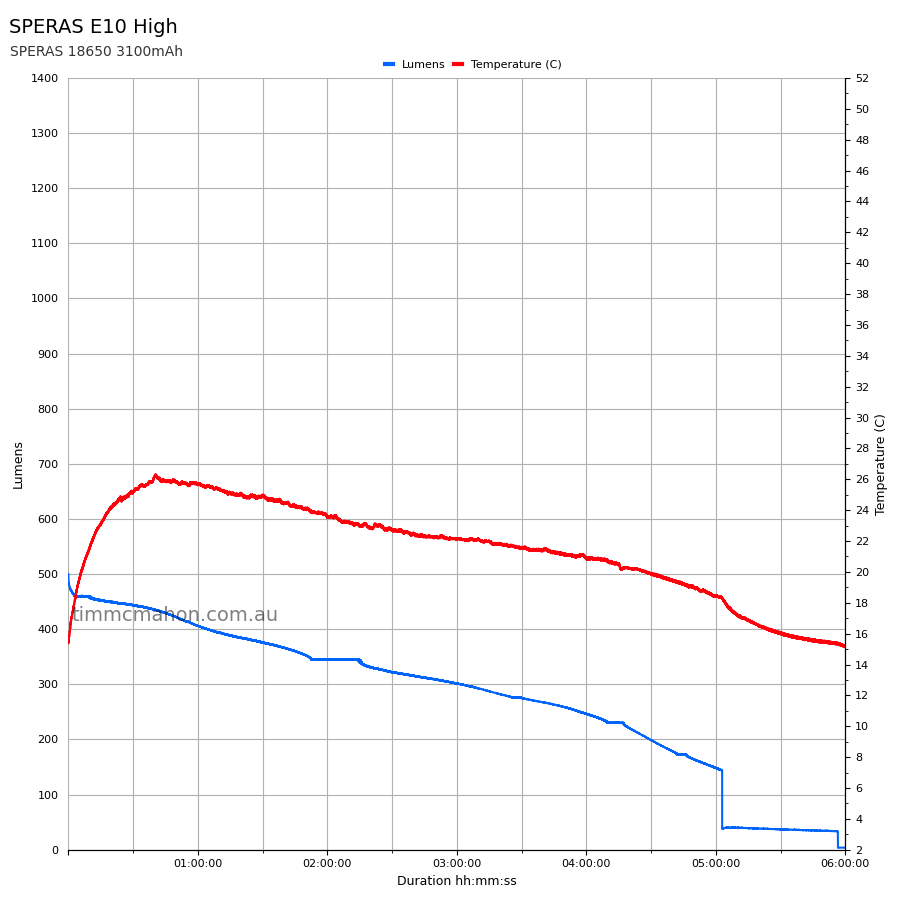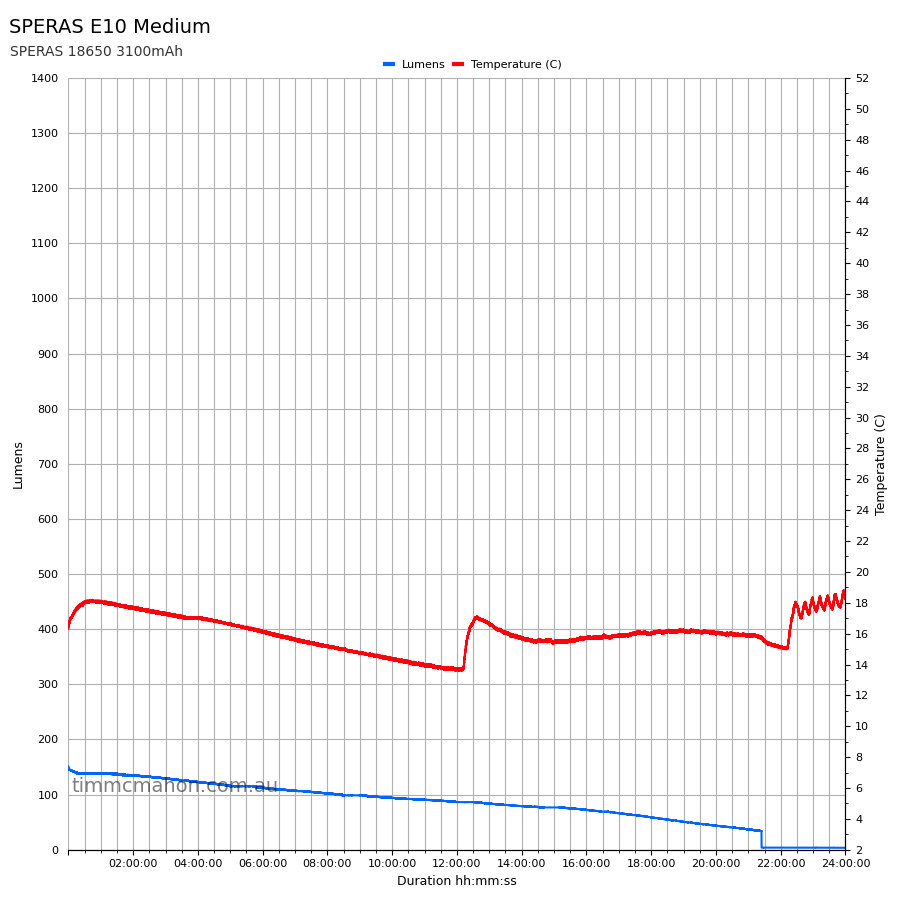SPERAS E10 Review
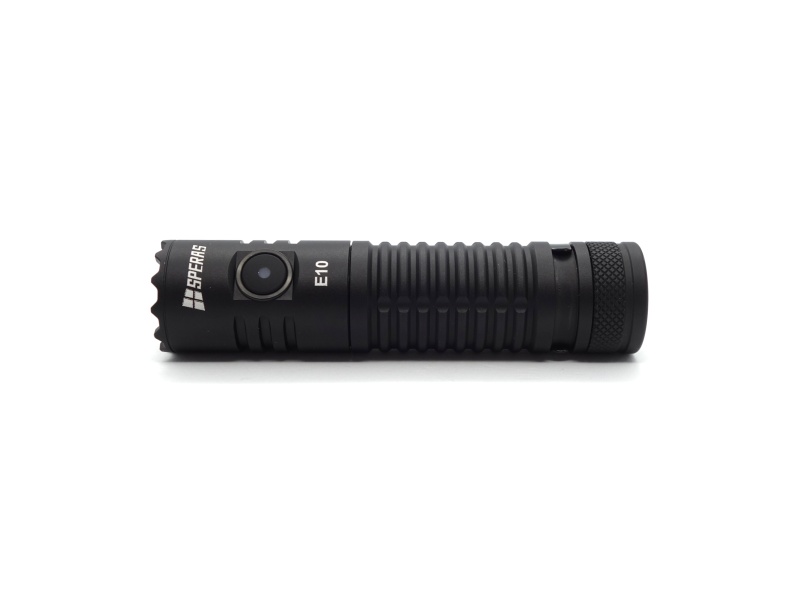
SPERAS E10⌗
- Specifications
- Introduction
- Torch in use
- Build quality
- LED, bezel, lens and beam
- Size and comparison
- User interface
- Batteries and charging
- Performance
- Beamshots
- Conclusion
- Product page
Specifications⌗
| Brand/model | SPERAS E10 |
|---|---|
| LED | 1*Luminus SST40 6500K |
| Maximum lumens | 1,300 lm |
| Maximum beam intensity | 7,625cd |
| Maximum throw | 211 m |
| Battery | 1*18650 Li-ion, 2*CR123A |
| Onboard charging | Yes (USB-A to USB-C) |
| Material | Aluminium |
| Modes | 4 |
| Blinkies | SOS, Strobe |
| Reflector | TIR |
| Waterproof | IP68 |
| Review date | August 2022 |
Introduction⌗
I have kept an eye on SPERAS to see what they are releasing after having a positive experience with my first torch from them, a M4 mini pocket thrower.
SPERAS announced the release of the SPERAS E10 side switch EDC torch recently.
I expressed an interest and SPERAS provided the E10 for review at no cost. I have not held back my opinions of this torch.
Packaging⌗
The E10 came in a white SPERAS branded retail box with a plastic tray.
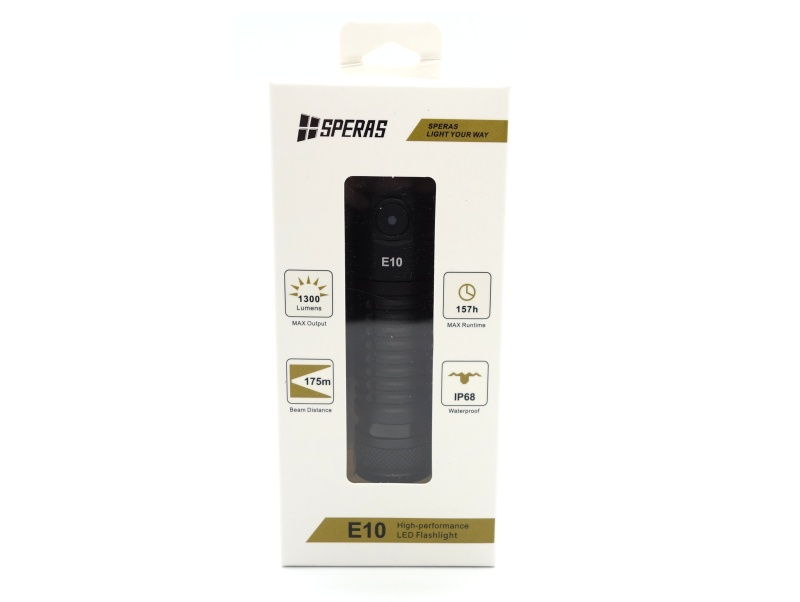
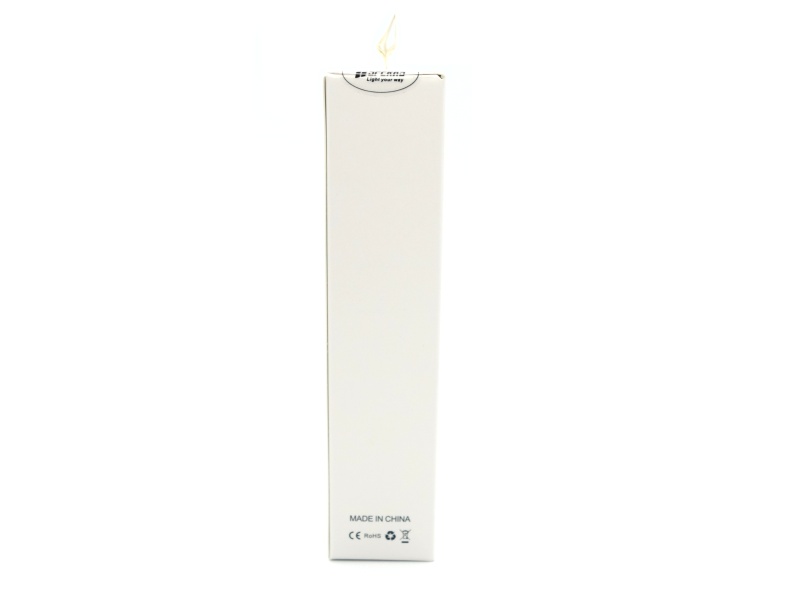
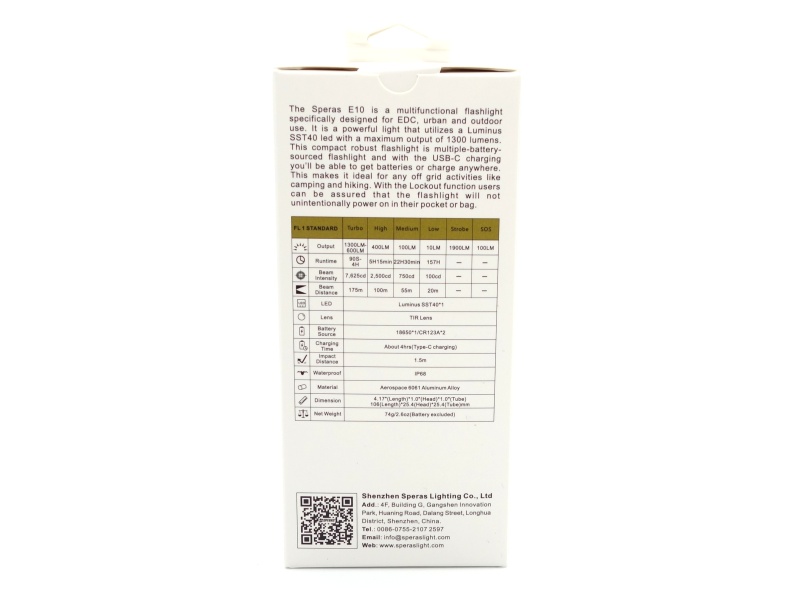
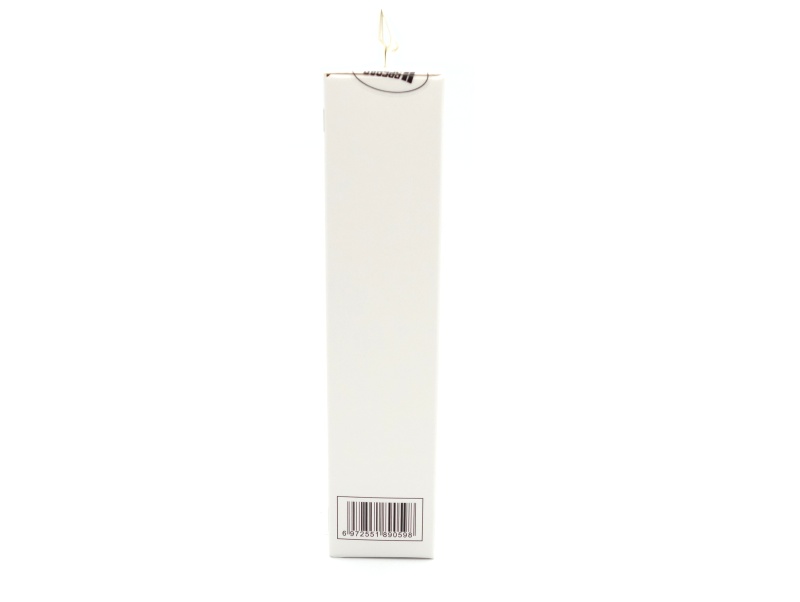
The following was included in the box:
- SPERAS E10
- SPERAS 18650 3100mAh Li-ion cell
- USB-A to USB-C charging cable
- Lanyard
- Two o-rings
- User manual
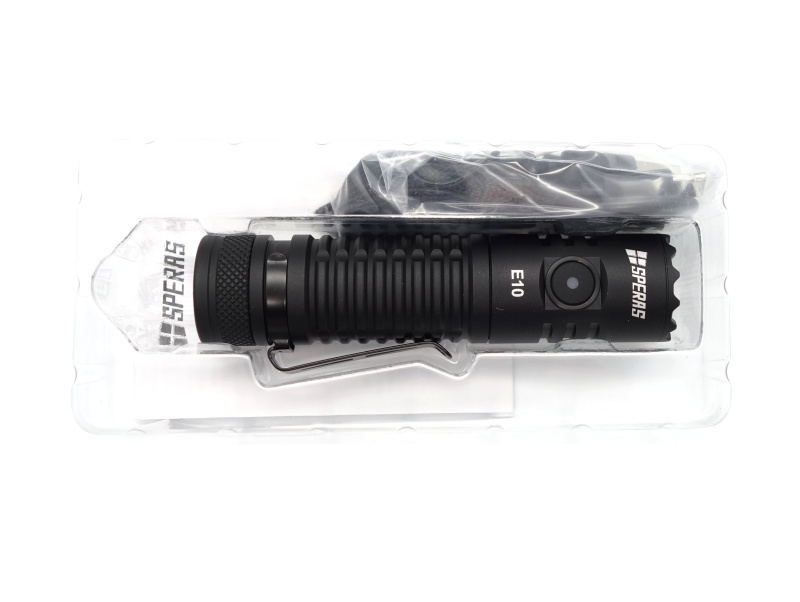
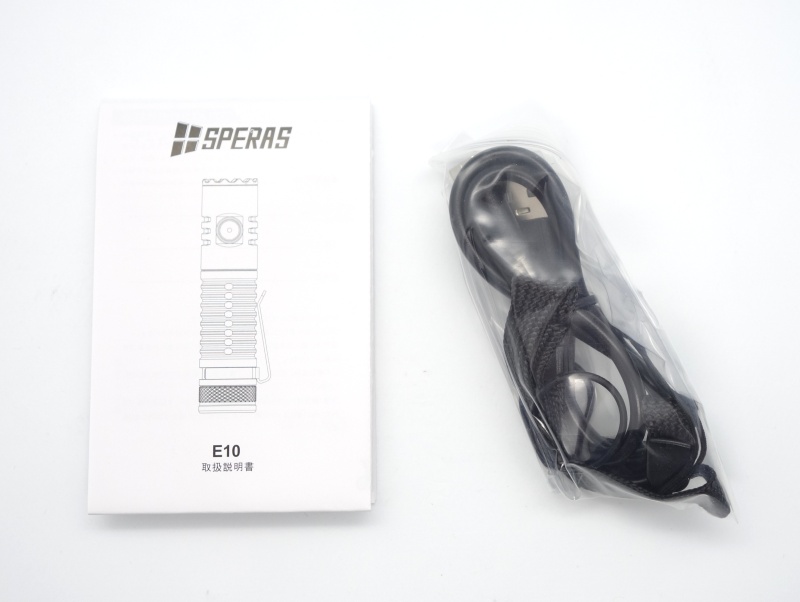
Torch in use⌗
The SPERAS E10 has an aggressive tactical look with the matte black finish, ribbed knurling and a small strike bezel. The torch matte finish and knurling give the torch a lot of grip. The torch feels a small in my hand.
A pocket clip fits snugly around the tube and easily clips onto a pocket. It is not a deep carry clip and it cannot be reversed.
The charging port cover feels sturdy and moves out of the way easily. I sometimes confused the side switch with the charging port cover when trying to find the switch at night.
A lanyard was included but the only lanyard hole that I could find is at the end of the pocket clip.
It would have been nice to see a magnet included in the tailcap given the small size of this EDC torch with a side switch.
The torch can easily tailstand.
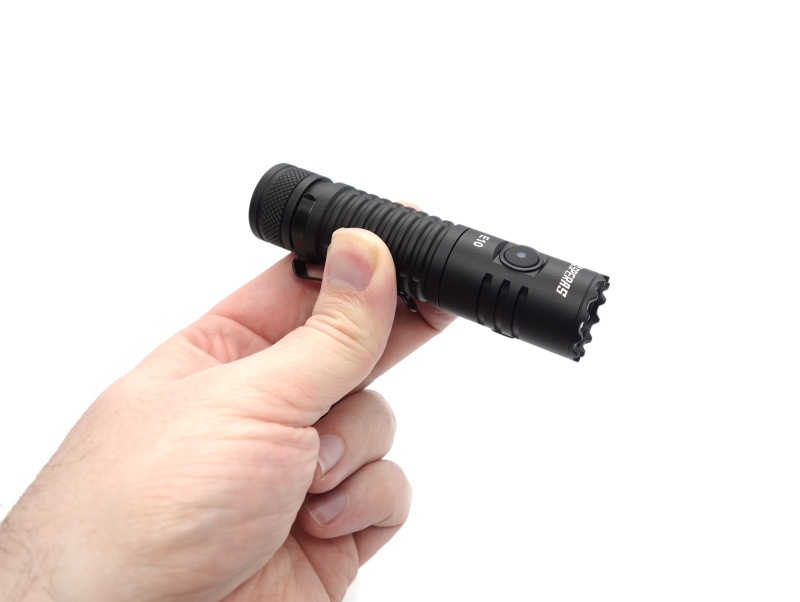
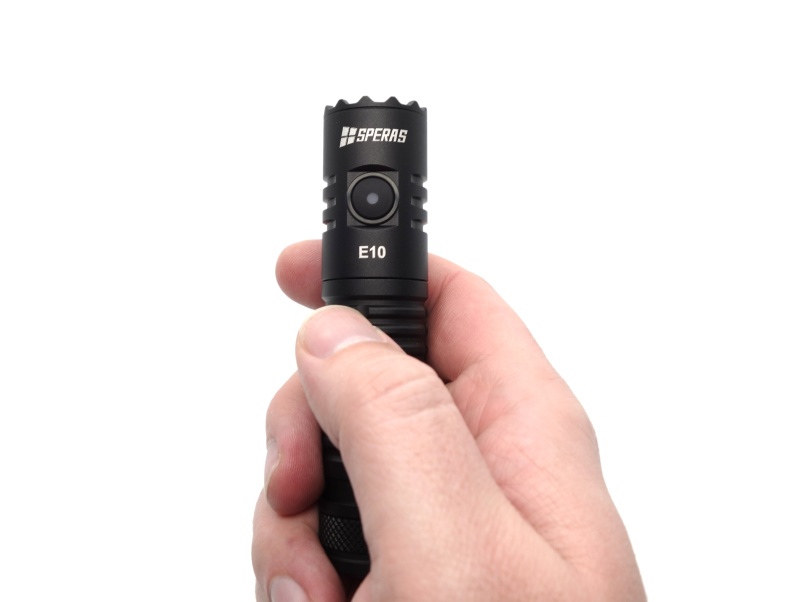
Build quality⌗
The torch is mostly constructed of aluminium. Anodising of the body and the inside of the tube looks good.
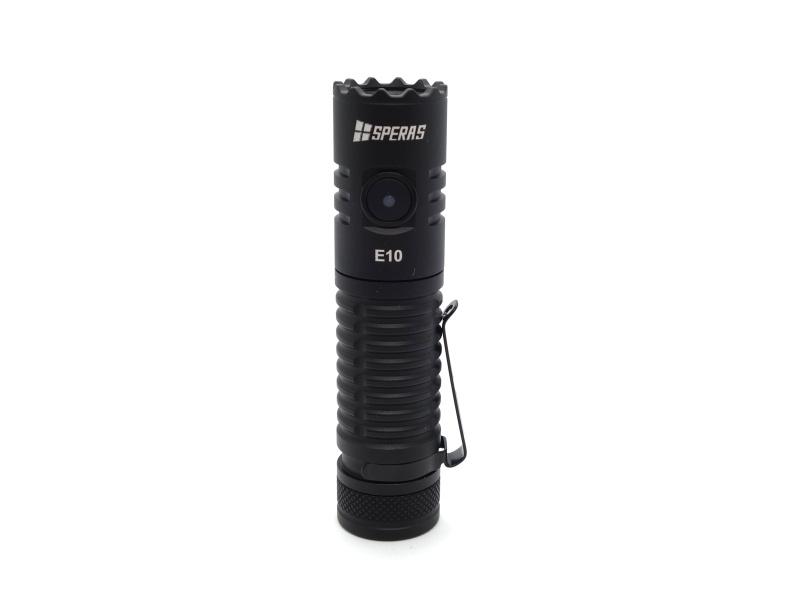
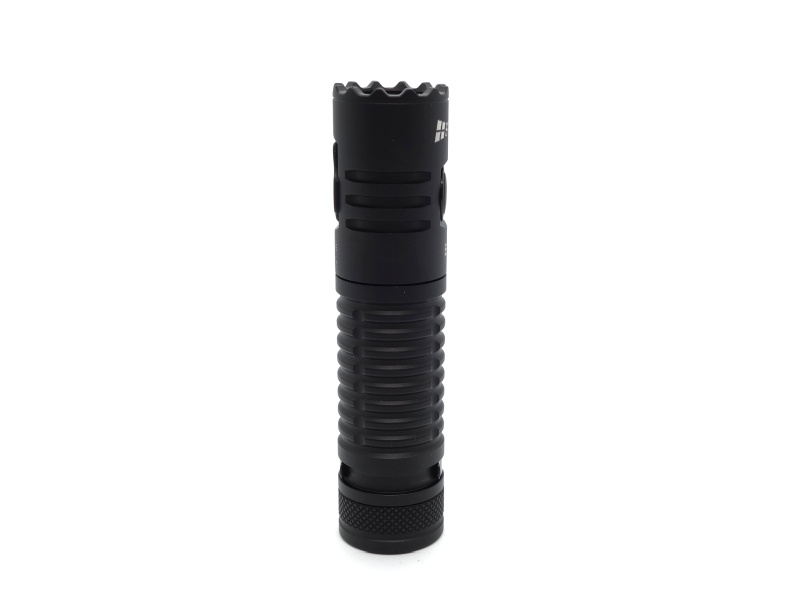
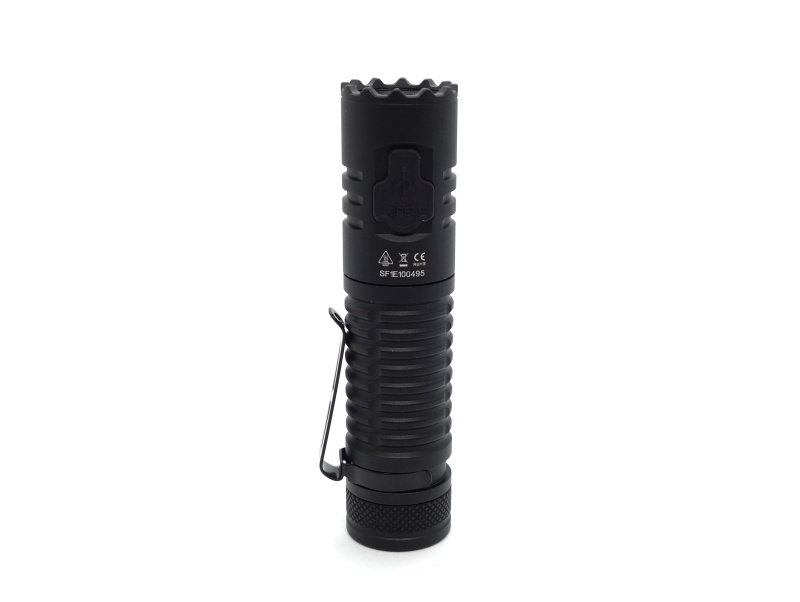
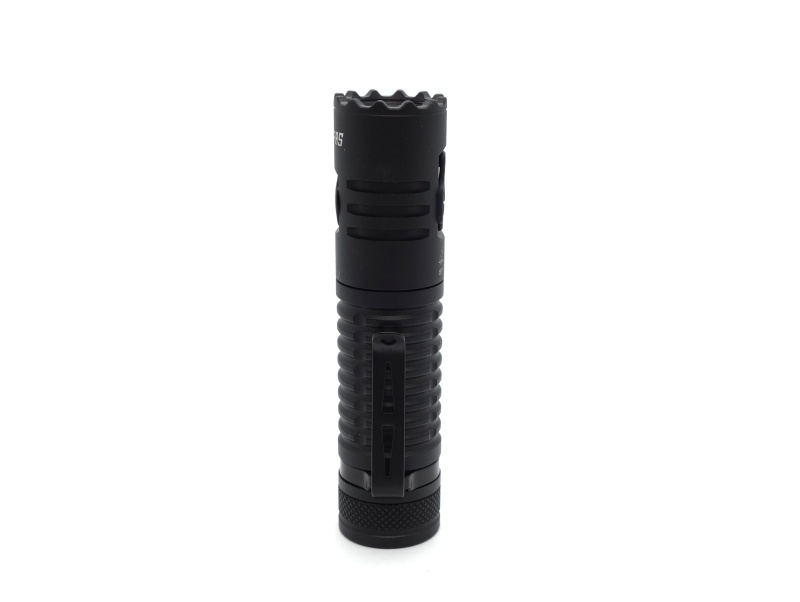
The fins in the head may be sharp if you squeeze them with your fingers but the rest of the torch is mostly smooth (aside from the strike bezel).
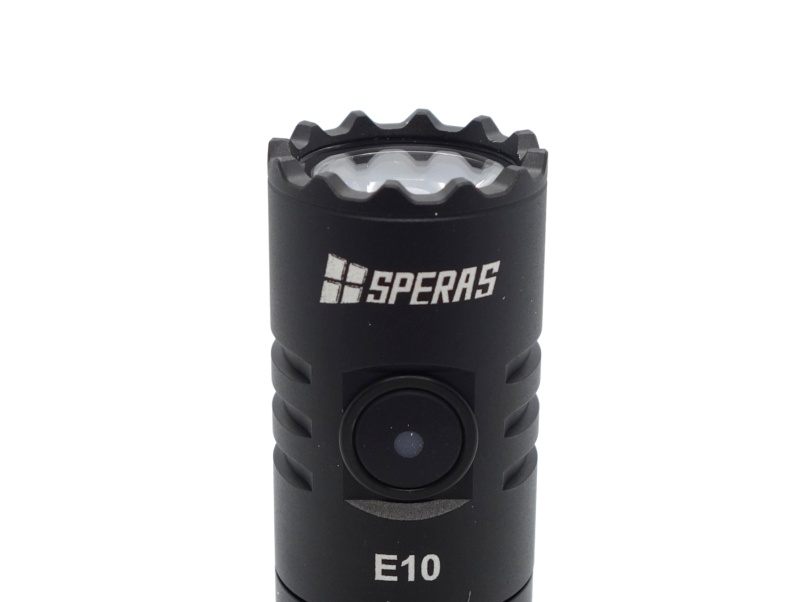
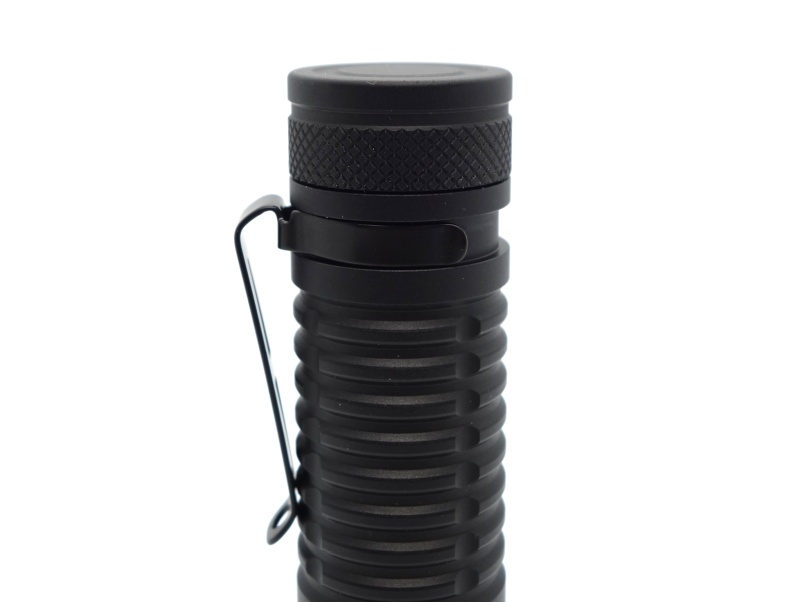
Square cut threads on the tube came lightly lubricated.
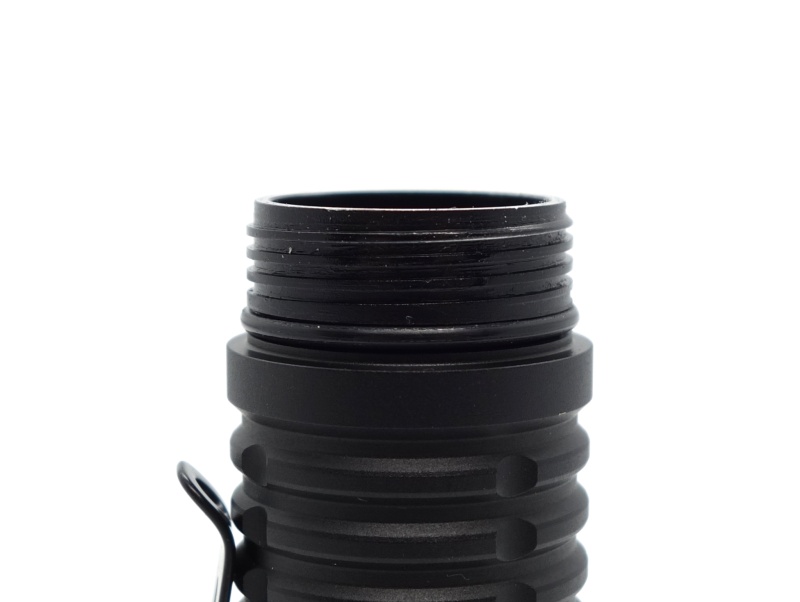
The springs at each end allow for flat top or button top 18650 cells or two CR123A cells to fit.
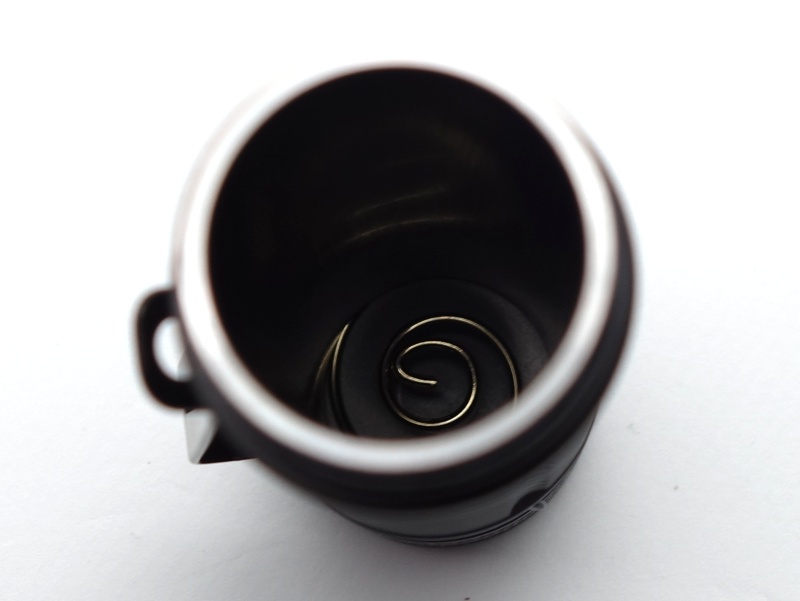
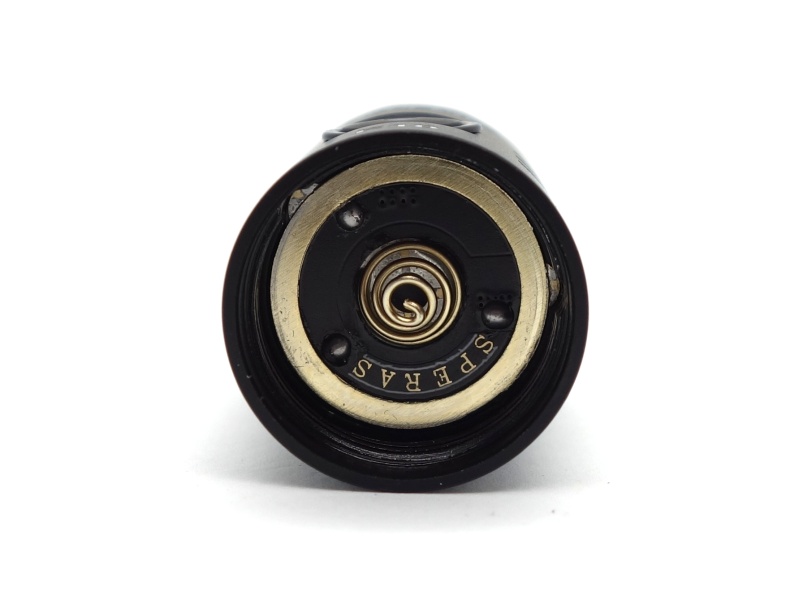
LED, bezel, lens and beam⌗
The E10 has a single Luminus SST40 6500K emitter behind a clear TIR optic.
A glass lens appears to be glued to a bezel. The bezel and head appear to be one piece.
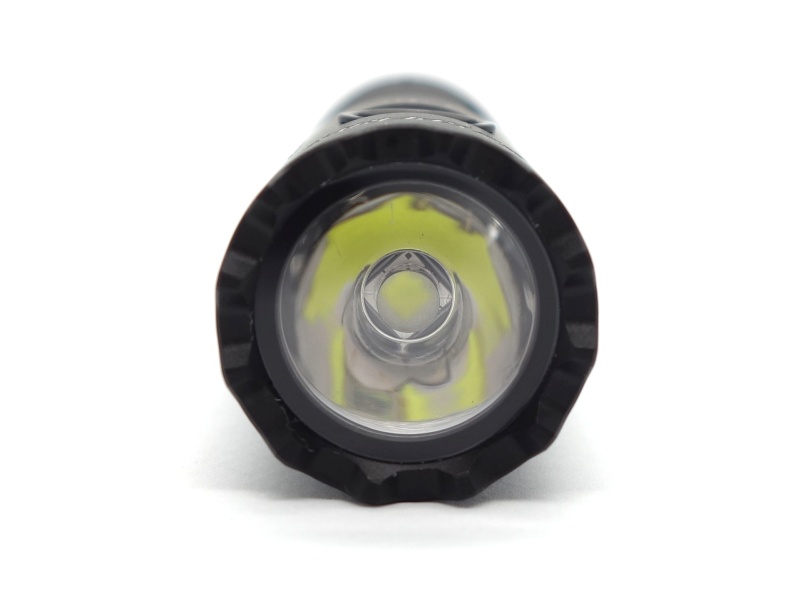
I have taken Correlated Colour Temperature (CCT) and Colour Rendering Index (CRI, RA of R1-R8) measurements with the torch positioned half a metre away from an Opple Light Master Pro III (G3).
The CCT is about 5500K and the CRI is 60+.
The Delta u, v is positive (green) on lower modes and closer to pure white on Turbo.
The beam has a white hot spot with a green corona and a bit of purple around the spill.
| Mode | CCT (K) | CRI (Ra) | x | y | Duv |
|---|---|---|---|---|---|
| Low | 5278 | 61.0 | 0.3389 | 0.3782 | 0.0152 |
| Medium | 5388 | 62.4 | 0.3356 | 0.3714 | 0.0135 |
| High | 5568 | 63.9 | 0.3308 | 0.3628 | 0.0115 |
| Turbo | 5708 | 64.9 | 0.3274 | 0.3556 | 0.0095 |
Calculate Duv from CIE 1931 xy coordinates
Dimensions and size comparison⌗
Dimensions⌗
I took the following measurements using digital callipers.
| Measurement | Unit (mm) |
|---|---|
| Torch length | 106.6 |
| Head diameter | 25.4 |
| Tube diameter | 25.0 |
| Lens diameter | 20.4 |
Weight⌗
I took the following measurements using a digital scale.
| Weight | Unit (g) |
|---|---|
| Torch | 67.2 |
| Battery | 48.8 |
| Pocket clip | 3.1 |
| Torch with battery and clip | 119.1 |
Size comparison with its competition⌗
From left to right: Acebeam E70 Mini, VezerLezer ED10, SPERAS E10, SPERAS EST, Brinyte E18 Pheme
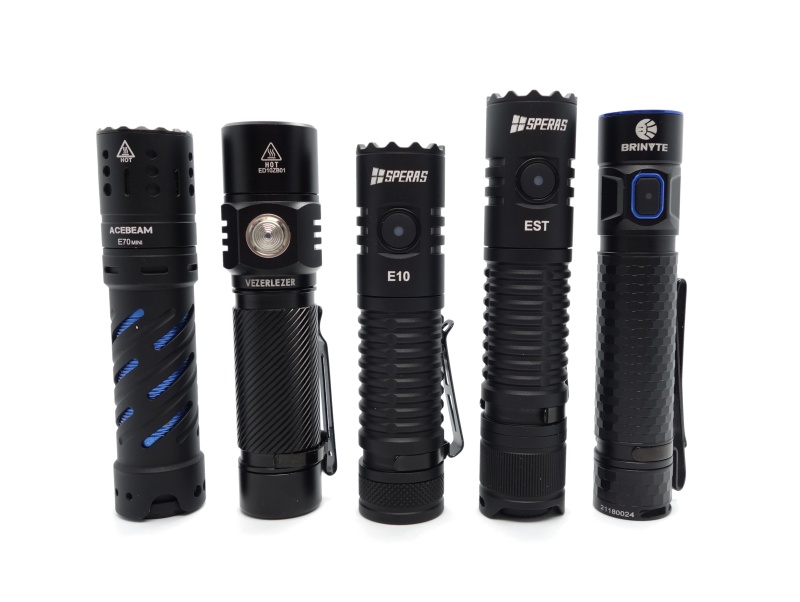
From left to right: Acebeam E70 Mini, VezerLezer ED10, SPERAS E10, SPERAS EST, Brinyte E18 Pheme
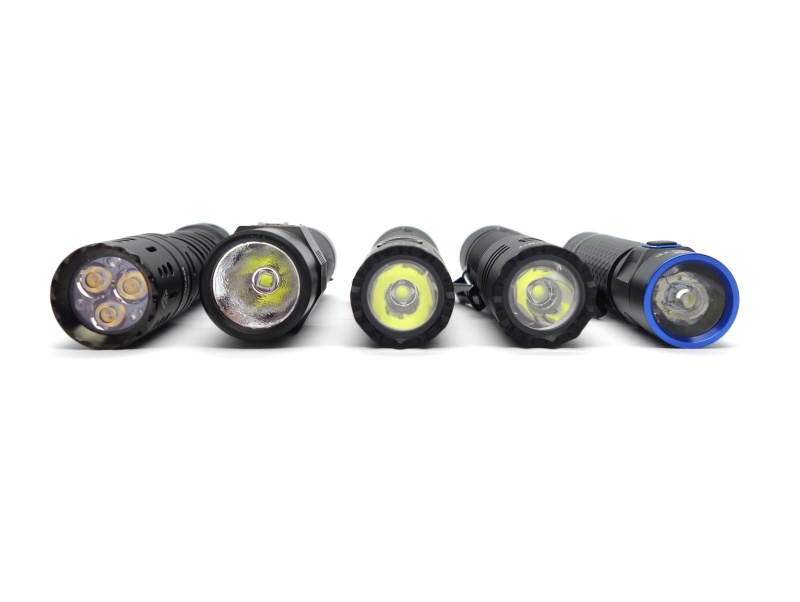
User interface⌗
The SPERAS E10 has a simple user interface with four main levels (Low, Medium, High, Turbo) and two blinkies (Strobe, SOS).
| State | Action | Result |
|---|---|---|
| Off | Click Side Switch | On (mode memory) |
| Off | Hold Side Switch 0.5s | Low |
| Off | Hold Side Switch 2.0s | Lockout |
| On | Hold Side Switch | Cycle (Low, Medium, High, Turbo) |
| Any | Double Click Side Switch | Strobe |
| Strobe | Double Click Side Switch | SOS |
| Lockout | Triple Click Side Switch | Deactivate Lockout |
Strobe⌗
The strobe frequency alternates between fast and slow blinks.
Battery status⌗
There is a battery capacity indicator LED in the side switch. The LED displays the following colour when the torch is on:
| Colour | Battery level |
|---|---|
| Green | Power ≥ 70% |
| Orange | 30% ≤ Power < 70% |
| Red | 10% ≤ Power < 30% |
| Red Flash | Power < 10% |
Low voltage protection⌗
The LED turned off at 2.25V and continued to consume 3mA when I used a bench power supply to test LVP. It would be better if the E10 turned off above 2.5V. It may take several weeks to fully discharge at that rate.
You could mitigate the risk of the apparent lack of LVP by:
- using a protected cell or,
- entering lockout mode or,
- removing the battery or,
- twisting the tube to mechanically lockout the E10.
In practice, when the battery voltage gets low, the battery status indicator flashes red to let you know that you need to charge the battery. The main white emitter remains on at a very low light output and this helpfully allows you to exit a dark area without being stranded in total darkness.
PWM⌗
I did not notice any visible PWM (flickering).
What I like about the UI⌗
- Simple and intuitive. Click for on. Click for off.
What could be improved⌗
- Direct access to Turbo from off would be nice.
Batteries and charging⌗
Battery⌗
The E10 takes a 18650 3.7V Li-ion cell (either button top or flat top) or two CR123A cells.
A button top SPERAS 18650 3100mAh cell was included inside the E10. The cell arrived with a voltage of 3.64V, and it was isolated with a piece of plastic to avoid standby drain.
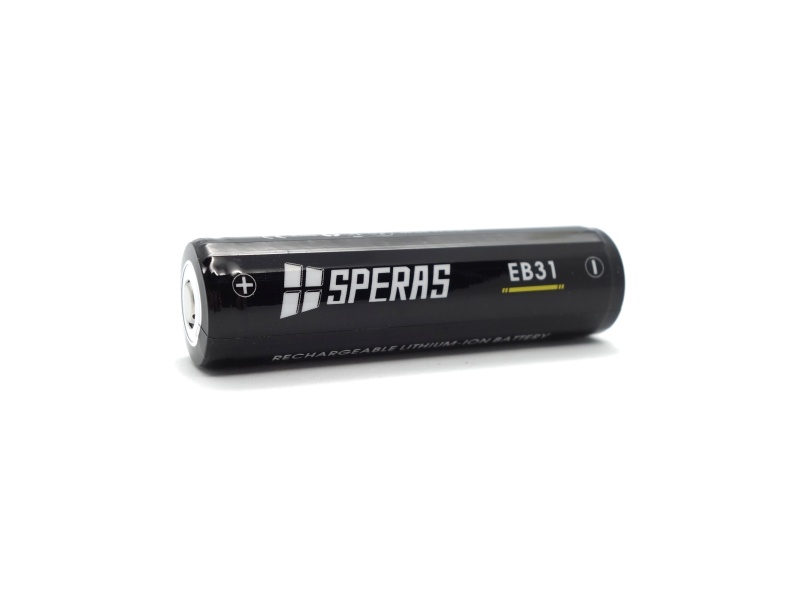
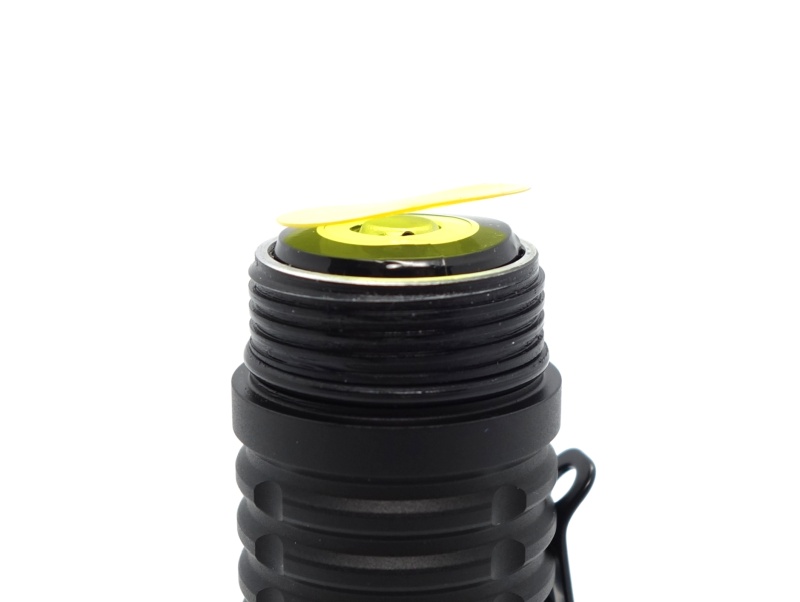
Charging⌗
The SPERAS E10 has built-in USB-C charging and came with a USB-A to USB-C cable.
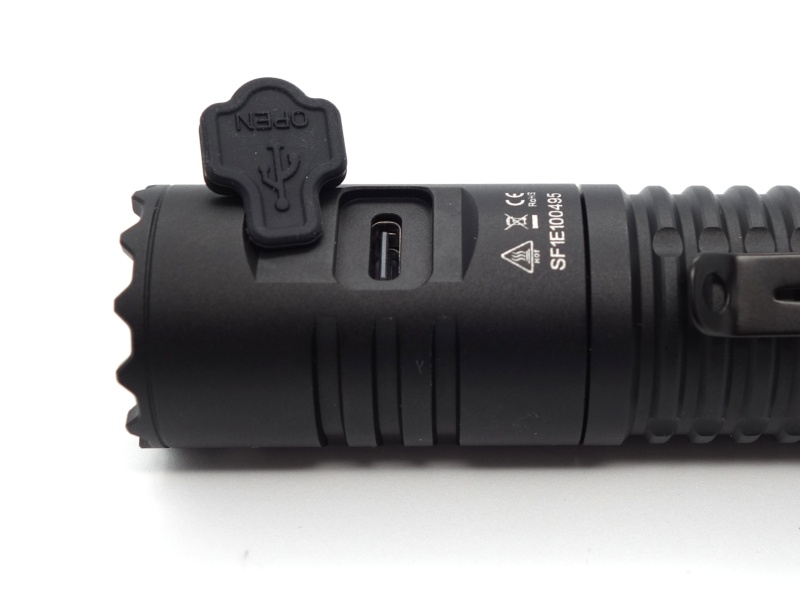
The indicator LED in the side switch is red while a battery is charging and it turns green when the battery is full. The indicator LED is orange when there is no battery or the battery has not been inserted correctly while charging.
Power source: Generic 5V 2.4A Power Supply
Room temperature: 16 C
USB Meter: Ruideng UM25C
I discharged the cell to 2.89V and then charged it in the E10.
The cell charged at 1A for over four hours. The current dropped gradually after the last one and a half hours and charging ended at 4.19V.
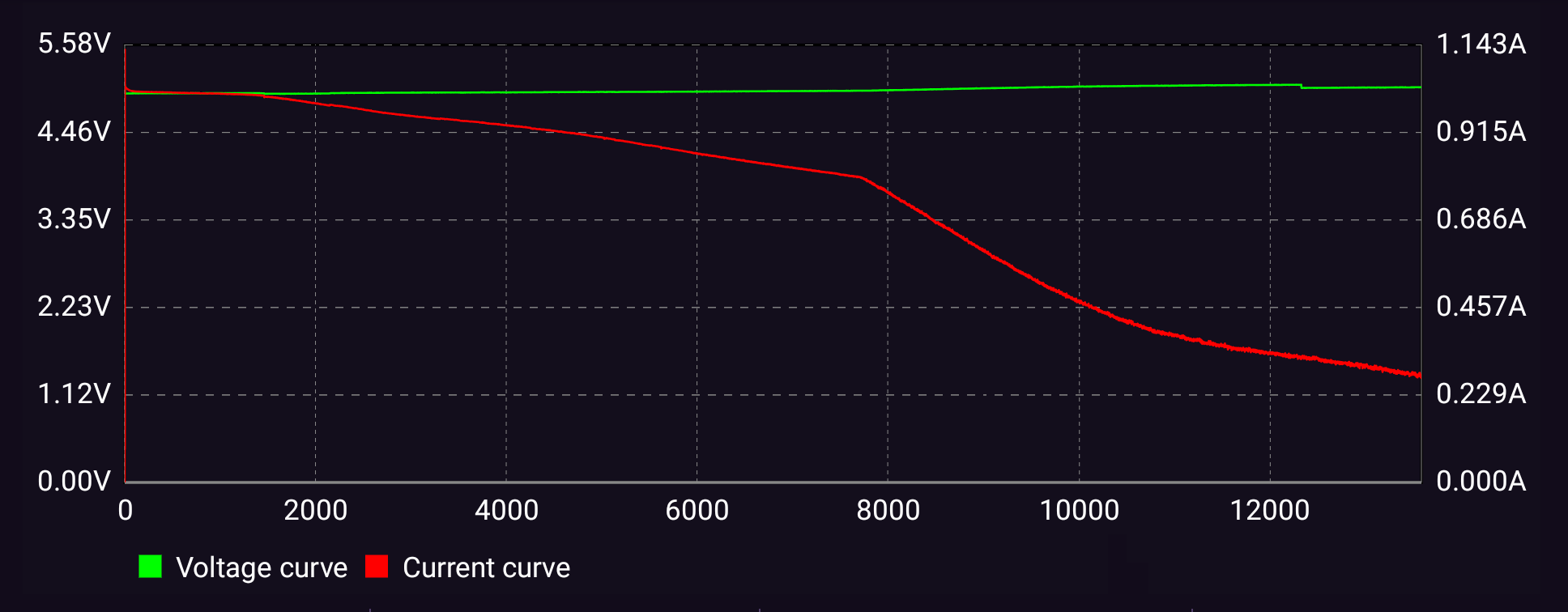
Power supply compatibility⌗
I tried the following power supplies with the Speras E10’s built-in USB-C charger:
| Power supply | USB Type | Protocol | Does it charge? |
|---|---|---|---|
| Apple 61W Power Adapter | USB-C | PD | No |
| Google Pixel Power Adapter | USB-C | PD | No |
| Generic 5V 2.4A Power Adapter | USB-A | Yes |
USB-C to USB-C did not work.
USB-A to USB-C works.
Performance⌗
Specifications from the manual:
| FL1 STANDARD | Turbo | High | Medium | Low | Strobe | SOS |
|---|---|---|---|---|---|---|
| Output | 1300lm-600lm | 400lm | 100lm | 10lm | 1300lm | 100lm |
| Runtime | 90s-4h | 5h15min | 22h30min | 157h | - | - |
| Beam Intensity | 7,625cd | 2,500cd | 750cd | 100cd | - | - |
| Beam Distance | 175m | 100m | 55m | - | - |
Lumen measurements⌗
| Mode | Amps at start | Specs | Lumens @turn on | Lumens @30 sec | Lumens @10 min |
|---|---|---|---|---|---|
| Low | 0.03 A | 10 lm | 19 lm | 19 lm | 19 lm |
| Medium | 0.21 A | 100 lm | 151 lm | 146 lm | 141 lm |
| High | 0.86 A | 400 lm | 499 lm | 477 lm | 458 lm |
| Turbo | 3.40 A | 1300 lm | 1360 lm | 1229 lm | 730 lm |
Standby drain⌗
67.4 µA.
Runtime graphs⌗
I built a lumen tube and forked bmengineer’s project RuTiTe to add support for a VEML7700 light sensor and MCP9808 temperature sensor with help from Owen. Calibration lights from maukka were used.
Note: Lumen measurements may be off by more than 10% with my DIY lumen tube. Temperature may vary due to the room temperature and it may be lower than expected due to how I attached the sensor.
Measurements were taken in my office where the ambient temperature may fluctuate between 6C and 21C during winter.
It is nice how SPERAS distinguished between Turbo starting at 1300 lumens and stepping down to 600 lumens after 90 seconds in the user manual. This transparency and honesty is appreciated and helps set expectations.
Turbo started at 1360 lumens and stepped down to 1167 lumens after 90 seconds. This is better than the 90 second claim. It dropped below 600 lumens after 30 minutes and continued to drop sharply until 4 hours. The E10 kept going beyond 4 hours with a very low light output.
High started at 499 lumens and gradually stepped down over 5 hours. The E10 kept going beyond 5 hours with a very low light output.
Medium started at 151 lumens and gradually stepped down over 21 hours 30 minutes. The E10 kept going beyond 22 hours with a very low light output.
I stopped runtime testing of Turbo and High at 6 hours, Medium at 24 hours, and Low at 10 minutes.
My runtime results were similar to SPERAS results. It would be nice if light output could be consistent for hours instead of gradually dropping.
Throw⌗
I took lux measurements with a UT383BT after 30 seconds for each mode. Turbo, High and Medium were measured at five metres. Low was measured at two metres.
The included 18650 cell was used. I charged it up to 4.20 V before measuring each mode.
| Mode | Specs (cd) | Specs (m) | Candela measured (cd) | Distance (m) |
|---|---|---|---|---|
| Low | 100 | 20 | 108 | 20 |
| Medium | 750 | 55 | 925 | 60 |
| High | 2,500 | 100 | 3,675 | 121 |
| Turbo | 7,625 | 175 | 11,075 | 210 |
Beamshots⌗
I went to a local park and aimed the SPERAS E10 at a tree 70 metres away while using Turbo.
Beamshots were taken using a Sony RX100M2 using 3.2", f3.2, ISO 100, 5000K WB.
SPERAS E10⌗
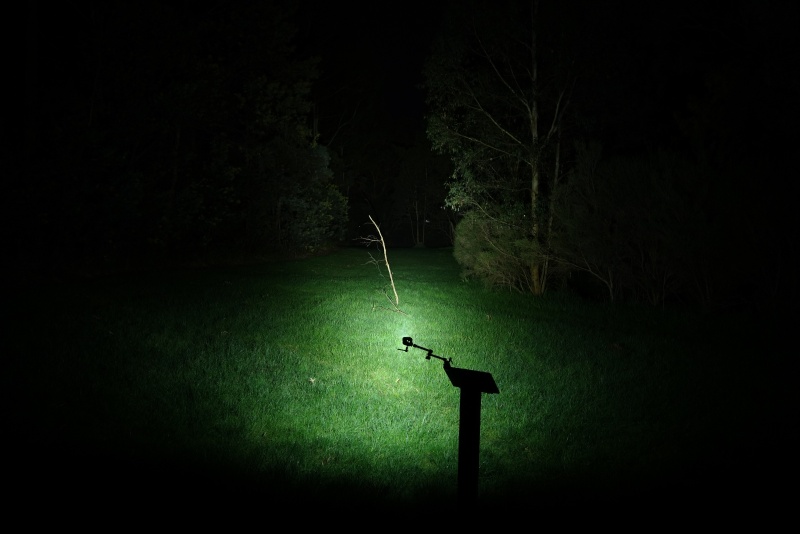
Brinyte E18 Pheme⌗
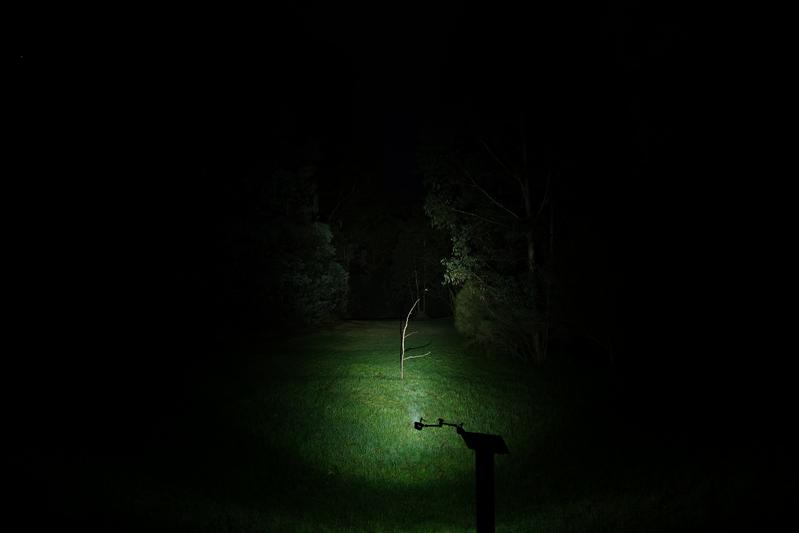
Olight Warrior Mini 2⌗
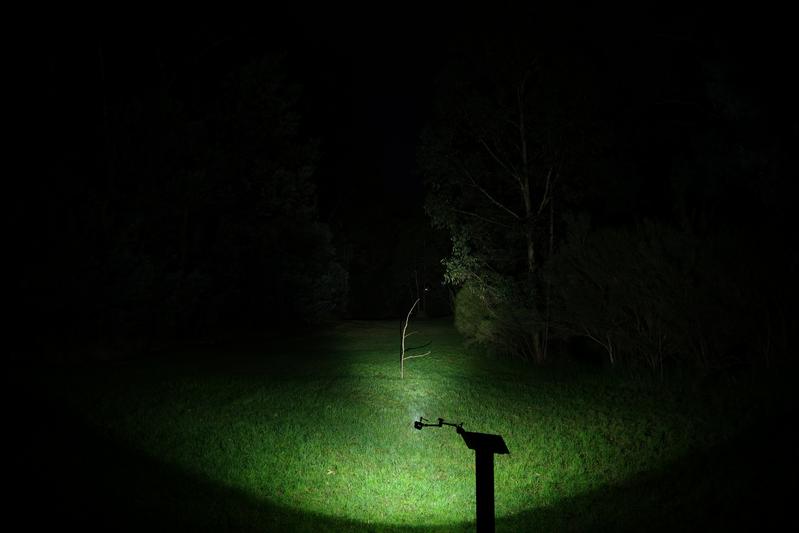
VezerLezer ED10 6500K⌗
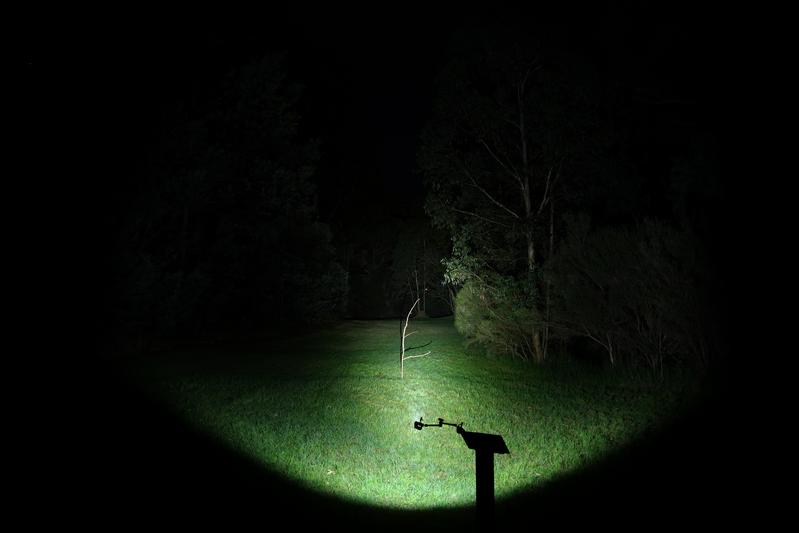
Conclusion⌗
The SPERAS E10 is a small tactical looking EDC torch with a good build quality and a decent runtime.
Pros:⌗
- Good build quality.
- Compact size.
- Simple user interface.
- Built-in USB-C charging.
Cons:⌗
- Low voltage protection issue.
- Low CRI emitter.
